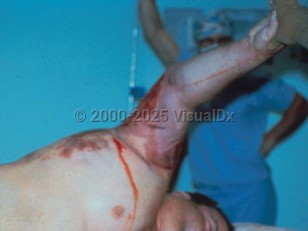Potentially life-threatening emergency
Gas gangrene
See also in: Cellulitis DDxAlerts and Notices
Important News & Links
Synopsis

Gas gangrene (also known as clostridial myonecrosis) is a very severe infection with high morbidity and mortality. Clostridial anaerobic bacteria are responsible for this necrotizing infection of muscle that may also be associated with infection of the adjacent skin and soft tissues.
The majority of cases of gas gangrene are seen after penetrating trauma (including motor vehicle accidents, gunshot wounds, or crush injuries). Recent abdominal surgery or a septic abortion may also predispose. Clostridium perfringens is the most frequent cause. Clostridium sordellii infections can affect women after vaginal delivery, abortion, or other gynecologic procedures. It can also affect individuals after injuries, surgeries, or illicit drug injection. Skin, muscle, uterus, or perineum may be affected. Clostridium septicum infections are commonly seen in nontraumatic gas gangrene. The infections occur in patients with colorectal cancer or in those with congenital or cyclic neutropenia.
In clostridial myonecrosis, the incubation period may be a few hours. Progression may be rapid, within hours. Fever and severe pain at the affected site ensue. Gas in the tissue causes crepitus on palpation and is a fairly late sign and is accompanied by a foul odor. Septic shock, with hypotension and organ failure, eventuates if the infection is not treated.
With deeply penetrating injuries, or in the other scenarios outlined above, blood supply is compromised, creating an anaerobic environment ideal for bacterial proliferation. The Clostridium bacteria produces collagenases and other proteases that cause tissue death. The alpha toxin is a phospholipase that is responsible for the vascular obstruction and subsequent loss of vascular perfusion that leads to tissue necrosis.
A subacute form of gas gangrene from nonclostridial anaerobic bacteria, such as Peptostreptococcus or Bacteroides, has slower onset and progression.
The majority of cases of gas gangrene are seen after penetrating trauma (including motor vehicle accidents, gunshot wounds, or crush injuries). Recent abdominal surgery or a septic abortion may also predispose. Clostridium perfringens is the most frequent cause. Clostridium sordellii infections can affect women after vaginal delivery, abortion, or other gynecologic procedures. It can also affect individuals after injuries, surgeries, or illicit drug injection. Skin, muscle, uterus, or perineum may be affected. Clostridium septicum infections are commonly seen in nontraumatic gas gangrene. The infections occur in patients with colorectal cancer or in those with congenital or cyclic neutropenia.
In clostridial myonecrosis, the incubation period may be a few hours. Progression may be rapid, within hours. Fever and severe pain at the affected site ensue. Gas in the tissue causes crepitus on palpation and is a fairly late sign and is accompanied by a foul odor. Septic shock, with hypotension and organ failure, eventuates if the infection is not treated.
With deeply penetrating injuries, or in the other scenarios outlined above, blood supply is compromised, creating an anaerobic environment ideal for bacterial proliferation. The Clostridium bacteria produces collagenases and other proteases that cause tissue death. The alpha toxin is a phospholipase that is responsible for the vascular obstruction and subsequent loss of vascular perfusion that leads to tissue necrosis.
A subacute form of gas gangrene from nonclostridial anaerobic bacteria, such as Peptostreptococcus or Bacteroides, has slower onset and progression.
Codes
ICD10CM:
A48.0 – Gas gangrene
SNOMEDCT:
80466000 – Gas gangrene
A48.0 – Gas gangrene
SNOMEDCT:
80466000 – Gas gangrene
Look For
Subscription Required
Diagnostic Pearls
Subscription Required
Differential Diagnosis & Pitfalls

To perform a comparison, select diagnoses from the classic differential
Subscription Required
Best Tests
Subscription Required
Management Pearls
Subscription Required
Therapy
Subscription Required
References
Subscription Required
Last Reviewed:06/06/2019
Last Updated:02/09/2023
Last Updated:02/09/2023

